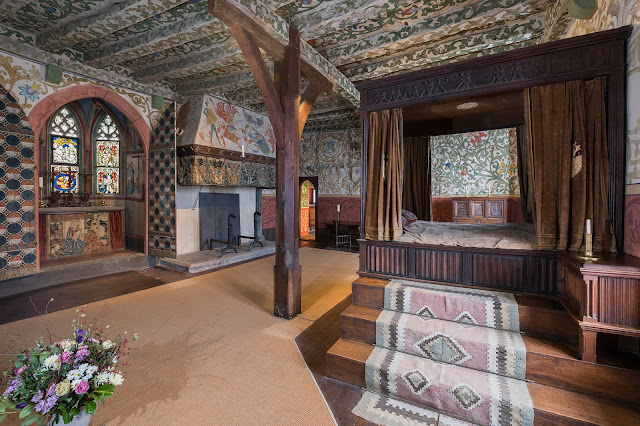This post continues the story of the creation of the tresoor of castle Hernen and concerns fitting the main parts of the tresoor together. Until this post, all parts of the tresoor were loosely fit and could be taken apart into individual pieces. In this post, most of the parts will be fitted together and fixed with wooden nails. The boards of the bottom display and the cupboard will be added as well.
Left: A lot of wooden pins were necessary for fixing the parts together. These are the split rough nails. Right: The square nails sized and pointed with a chisel.
A very useful jig. The adjustable lamp stand - a long plank with a hole for the swivel arm lamp which could be clamped anywhere on the tresoor.
At this point we decided that a decorative groove around the edges of
the
panelframes would make the tresoor more appealing. For the panels of
the cupboard, the wooden frame could still be taken apart and the
groove easily made on a router table with a V-bit. For the
frame at the back with the linenfold panels another set-up was chosen
as the horizontal rails had multiple short stretches of grooves and
using a hand router with a guiding rail offered more control of making the
grooves. The connection between the horizontal and vertical grooves were
cut by hand with a chisel and gouge.
Router set-up for the horizontal rails of the back of the tresoor. Each horizontal rails had four short stretches and this set-up allowed more visual control when using the router.
Left: For the router set-up, the guiding rail needed very precise placement to ensure the groove also was horizontal. Right: One groove was forgotten on the router table and had to be made with the hand router as well.
Grooves were made on the top of the panel frame and the sides. The bottom of the panel frame was planed at an angle. The end of the groove (indicated by the 2 pencil lines) was cut by hand with a gouge.
The angle connecting the top en side groove was cut by hand (indicated by pencil marks). The grooves towards the panel were rounded with a scraper.
Using a Veritas corner rounding tool to smooth the edges of the frame.
Bottom cupboard and bottom display planks consisted of 18 mm oak planks. They were connected to each other with a non-fixed groove en tongue joint. For the bottom of the cupboard also grooves needed to be cut into the horizonal and vertical rails. The planks for the cupboard were thus enclosed and fixed by the side walls of the cupboard. The boards for the bottom display are just resting on the frame, but semi-fixed by the two vertical standing stiles. An extra supporting rail was added in the middle for the bottom boards.
A groove was sawn and cut with a chisel in the vertical rail to support the planks of the cupboard.
The set-up for the bottom of the cupboard without the planks.
Left: The set-up with one of the planks added - top view. Note that the board has a groove for the tongue of the next board. Right: The set-up with one of the planks added - bottom view. You can see that the back of the plank rests on the rail of the backside.
The next board needs to be sawn at an edge.

The second board added for the cupboard.
The bottom board consisted of three parts; the middle one needed a complex cut-out for the pentagon stile.
A lot of clamps were needed for this process, and luckily we had a lot
of clamps. But clamping an edge of 45 degrees or as thin as 1-2 cm is
difficult, so some clamping jigs were used. After the main parts of the tresoor were fixed, the tresoor was sanded and oiled with linseed oil. The crown and the metal fittings are still missing.
This was the easiest part to construct. Only four large clamps were needed.
Pins added at the mortise and tenon joints of the backside of the tresoor.
Left: The horizontal parts of the sides could be easily clamped to the backside, as they stood at an 90 degree angle. Right: Each 'side of the tresoor had its own number, and the parts with the corresponding numbers fitted exactly.
The grooves were oiled with linseed oil before the panels were added. The panels were already oiled and dried.
To clamp the next pentagon sized vertical rail some clamping jigs with a V-groove were used.
The remaining three sides of the cupboard needed to be
added and clamped together. Also the rails for the drawer was added at
this time. A lot of clamps and clamping jigs were used in this process. You can see the pins sticking out at various joints.
A photo of a test set-up showing how the drawer rails are fixed between the back and front. Two mortise and tenon joints were used, but no pins were necessary here.
The mortise and tenon joints of the cupboard were fixed by two pins.
For the bottom planksan extra supporting rail was added. At the back a dovetail joint was used, at the front a mortise and tenon joint.
Adding two of the boards helped in retaining the correct angle when the bottom of the tresoor was clamped. Space was much less here and it was near impossible to drill the holes for the pins. The bottom supporting rail in the middle was fixed with a pin after the bottom panel frame was fixed.
After the bottom was fixed with pins, it needed some adjustment with rabbet and bullnose planes to allow the third and final board to be placed.
Everything sanded and oiled. Only the door with the metal fittings and the crown are missing.



























































